Sean McVay vs. Kyle Shanahan: The NFL’s Best New Coaching Rivalry
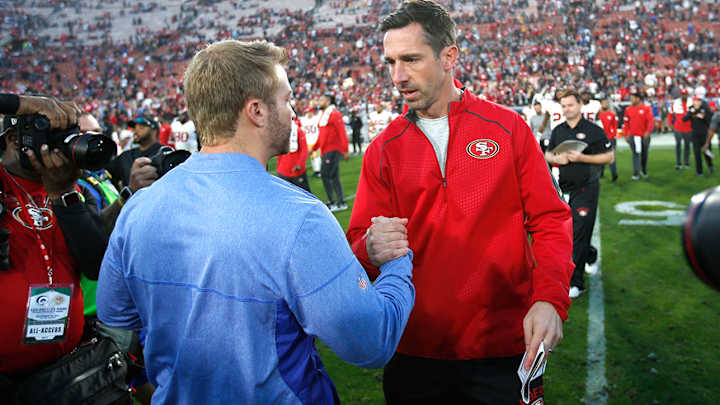
With the Rams, 49ers, Chargers and Raiders all offering compelling storylines and the promise of the playoffs, 2018 is shaping up to be the most anticipated season ever for pro football in California. The MMQB’s Andy Benoit is diving into those storylines for our special offseason project: California Week. Check back regularly for more.
Every year at the combine I meet with dozens of NFL head coaches, coordinators and assistants. It’s unfiltered, off-the-record football talk, and the question I always pose before departing is, From a schematic standpoint, which offenses impressed you most last year? Who are you studying this offseason?
This year, for the first time, every coach cited the same two teams: the Rams and 49ers. More telling, these were the only teams cited. No one mentioned the Patriots, Saints, Falcons or Chiefs. The Eagles came up, but only when we were talking run-pass options. The NFL is a copycat league, and the entire league spent this offseason trying to copy the leading contenders from the NFC West.

This is the story about the two coaches behind these envied offenses, where they learned their schemes, how those schemes work, what it means for the rest of the league—and why it’s about to give us the NFL’s greatest coaching rivalry.
Kyle Shanahan first met Sean McVay in 2010. Shanahan, now 38, was the offensive coordinator for his father, Mike Shanahan, with the Redskins. McVay, now 32, was hired by Washington as an offensive quality control coach. “I was basically Kyle’s assistant,” says McVay, who would become the tight ends coach in the second of his four years under Shanahan.
“I could tell within about five minutes that he was going to be a very good coach,” says Kyle Shanahan. “He was exactly what I wanted.” Both young coaches entered the league as quality control guys under Jon Gruden with the Buccaneers—Shanahan in 2004-05, McVay in 2008. Quality control is the grunt work of coaching. You gather and organize the scouting data on other teams. You break down the same on your own team. You draw the plays the head coach or coordinator will install. Anything that makes the jobs of other coaches more efficient, you do.
“Having had that experience, we were able to speak the same language,” says McVay. “That West Coast offense verbiage.” A quality control job under Gruden may be overwhelming in the short-term, but it’s big boon to a coach’s development long-term. Gruden is known to liberally add plays to his system. If he sees something another team runs well, he’ll install it. His quality control coaches are left to track seemingly endless concepts around the league. They learn a lot very quickly.
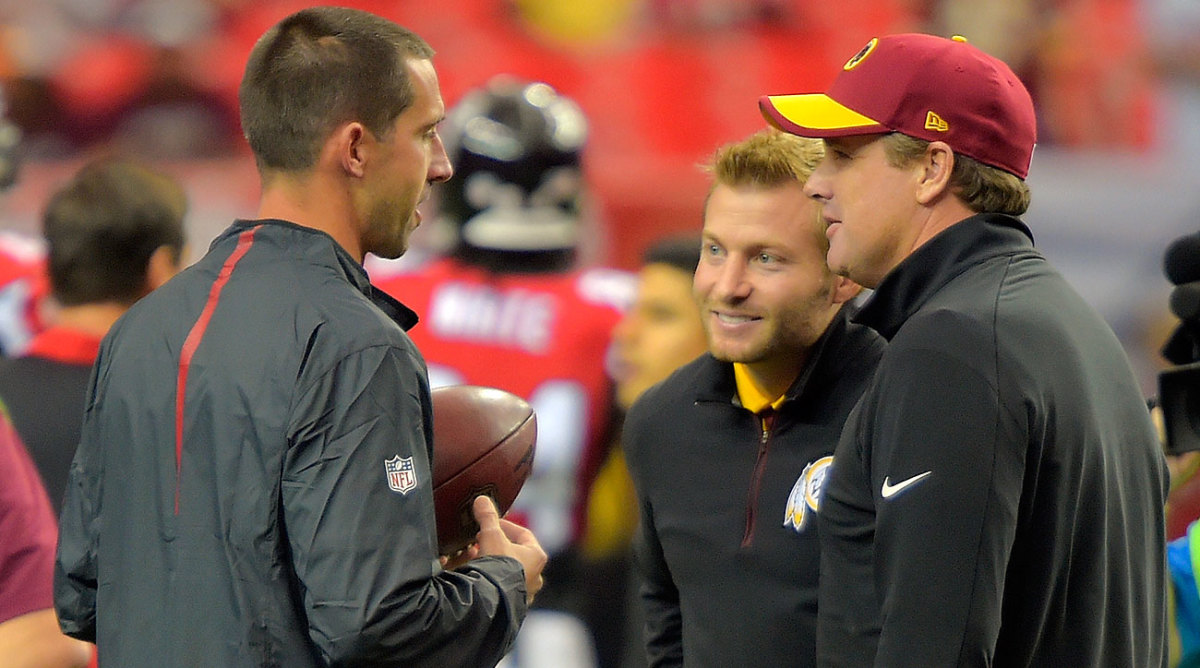
McVay to this day still has many of Gruden’s mannerisms. This was even more pronounced early in his career—something Shanahan and others would tease him about. The two young Redskins coaches admired one another, but their lives were not aligned for a close out-of-office friendship. McVay was a bachelor; Shanahan had a wife and young kids. They also have different personalities.
“Sean is going to be more rah-rah, positive, high-energy, warm,” says Kirk Cousins, who had Shanahan as a coordinator in 2012-13 and McVay as a coordinator under Jay Gruden in 2014-16. “Kyle’s going to be more direct, tell it like it is. I think that’s the biggest difference.”
New Titans offensive coordinator Matt LaFleur, now 38, was Washington’s QB coach from 2010 to ’13, later worked as Shanahan’s QB coach for two years in Atlanta and was McVay’s offensive coordinator last year in Los Angeles.
“Kyle’s intentions are extremely pure,” LaFleur says. “He wants what’s best—he just has a different belief in how to motivate people. Sean is more positive. They’re both demanding, just very different leadership styles.”
Wide receiver Pierre Garçon played for both Shanahan and McVay in Washington and now is with the former in San Francisco. He describes McVay as “more playful,” but touts Shanahan’s dry humor, which even after six years, can be hard for the veteran to detect. “He’ll crack a joke when you’re not expecting,” he says. “And now he’s the head coach, so it’s even harder to know if he’s serious or not. When young guys come in, they’re not sure if he’s messing with them or if he’s being serious, because he keeps such a straight face.”
As football guys, both have always been precocious.
“The first time I met Sean, I knew this guy was going to be a future head coach,” says LaFleur. “He’s so damn intelligent. His memory is as good as anybody I’ve ever been around. It’s scary good. He can see one thing from another team five years ago and recall the game and what quarter it was in, what part of the field it was on.
The NFL in California in 2018: The Best Year Ever?
“I think Kyle is a visionary—just look at the different styles of offense he’s been able to work with. Starting with our days with Robert Griffin back in 2012, where he had the foresight to create an offense that was conducive to what Robert did well.”
Cousins paints a similar picture of Shanahan’s adaptability. “When I came to Washington and Kyle installed the offense, he explained that we throw hot [routes], so we don’t need to deal with changing the protections very often, just let the system work for you. But I heard that when Kyle went to Atlanta, Matt Ryan said, ‘You know, I’d like to have sight adjustments [a sibling of hot routes]. They sort of went back and forth on it, and ultimately Kyle relented. Kyle didn’t want to do [sight adjustments] in the past, but he was willing to adjust because it was something Matt had done before.”
Of course, a scheme can only be as good as the men executing it. As McVay puts it, “The number one thing is, it’s all about the players. All these plays can be cool, but I know this—and I’ve heard Coach [Bill] Belichick say this: Players win games. It’s about putting these guys in the right position.”
In a literal sense, putting players in the right position is the art of scheming. McVay might come from the Gruden tree, but it’s a core Shanahan philosophy that defines his system. “We want to have that marriage of the run and the pass game,” he says. Shanahan describes it as having different plays that start out looking the same.
As Cousins explains, “Sean’s and Kyle’s quarterback can have a lot of success in the play-action game because those passes look like runs. They create a lot of explosive plays off of that. They also create a lot of explosive plays when they can change the tempo and go no-huddle.”
Plays that start out looking the same generally stem from a zone-blocking ground game, where the offensive line moves in unison. Both coaches subscribe to this approach. The passing game is where their styles differ.
Jimmy Garoppolo Takes Charge, Richard Sherman Steps In: 10 Thoughts on the 49ers
In the second half of last season, McVay used three wide receivers and one back nearly 90 percent of the time. He often aligned those receivers tight to the formation, where they were threats to run-block and had enough field around them to go left or right after the snap. That two-way go, mixed with outside zone runs, make more play-design possibilities available. The Rams capitalized with a precise timing-and-rhythm aerial attack and clever backfield passing game that often leveraged running back Todd Gurley off the wide receivers’ routes.
Shanahan, on the other hand, played with two wide receivers and two backs on around half the snaps once Jimmy Garoppolo stepped in—an exceptionally high rate. Two backs or two tight ends is considered “base personnel,” which, as the conductor of Atlanta’s Super Bowl offense in 2016, Shanahan had employed more than every NFL team except Tennessee. The second tight end—or often in San Francisco’s case the second back, fullback Kyle Juszczyk—serves as an extra, movable blocker, which adds significantly more variables to a running game. Having to account for those variables makes the defense more predictable in coverage, and Shanahan designs passes specifically exploiting that predictability. Those pass concepts tend to be simple, but Shanahan gives them the illusion of complexity by sending backs and tight ends in motion before the snap and presenting the same routes from different formations. This not only adds window-dressing—it also often forces the defense to reveal whether it’s in man or zone coverage.
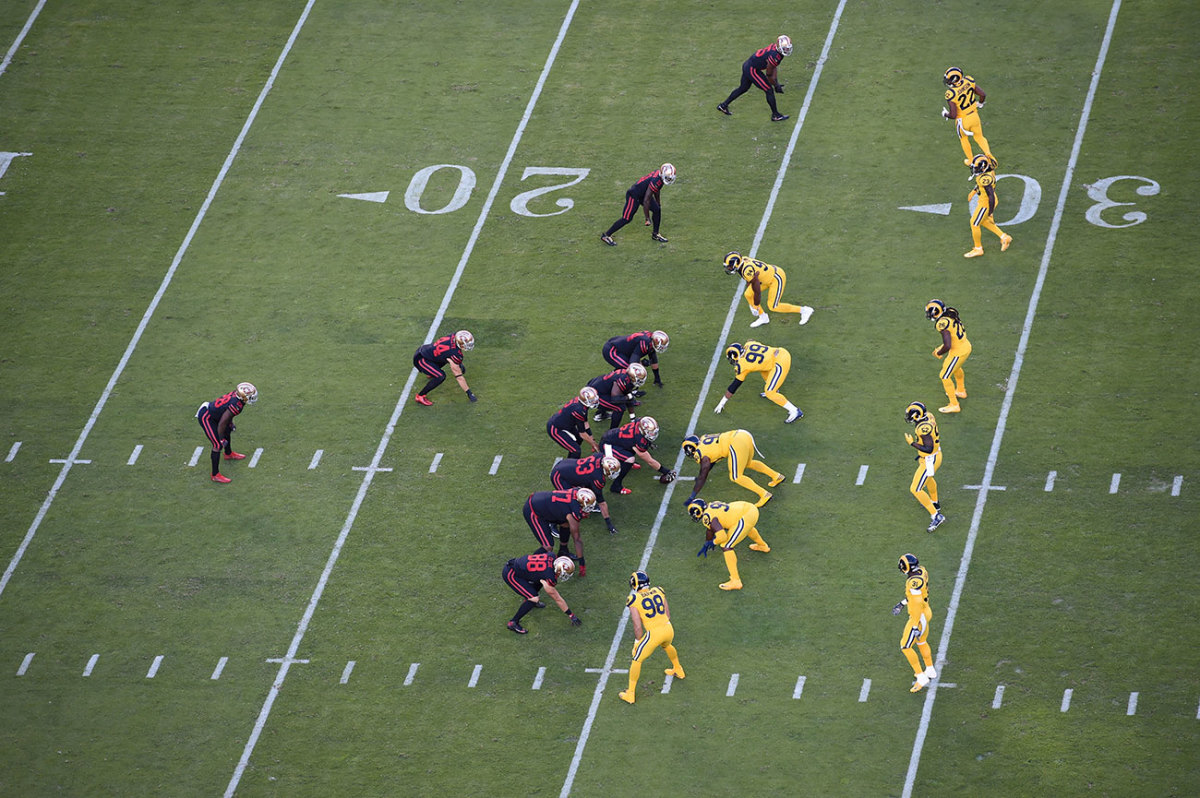
While Shanahan blurs a defense’s picture before the snap, McVay is more inclined to blur it immediately after. The Rams make great use of switch and stack releases, with receivers’ routes intersecting off the line, distorting defenders’ coverage assignments. He’s also become aggressive in jet motion and ghost reverse action, with wide receivers speeding across the backfield from one side of the formation to the other.
This isn’t to say Shanahan doesn’t employ switch releases or ghost action, or that McVay doesn’t use motion and formation wrinkles to decode a defense. As different as their schemes are, the coaches’ shared history creates plenty of overlap.
Nowhere is that more evident than in how they use their quarterback in the hurry-up approach mentioned by Cousins. Much was made last season of McVay rushing the Rams to the line and then talking into QB Jared Goff’s headset. But McVay is far from the first to do that, and it’s a tactic Shanahan has employed. He leaned on it heavily last year when Garoppolo took the field before he could possibly have learned San Francisco’s entire system.
The NFL’s Most Dynamic Team? 10 Thoughts on the 2018 Rams
Another approach both coaches take is to emphasize the tailback in the passing game. McVay did this steadily with Chris Thompson in Washington, then got to Los Angeles and found out that Gurley was unstoppable outside in space. Screens and passes to the flat became a Rams staple. Shanahan made great use of star tailbacks Devonta Freeman and Tevin Coleman through the air in Atlanta. In hopes of recreating that, the Niners this past offseason spent $30 million over four years for free-agent back Jerick McKinnon, formerly of the Vikings. He’ll pair at times with 2017 fourth-round receiving back Joe Williams and, more often, with Juszczyk, who last December was featured more on passes.
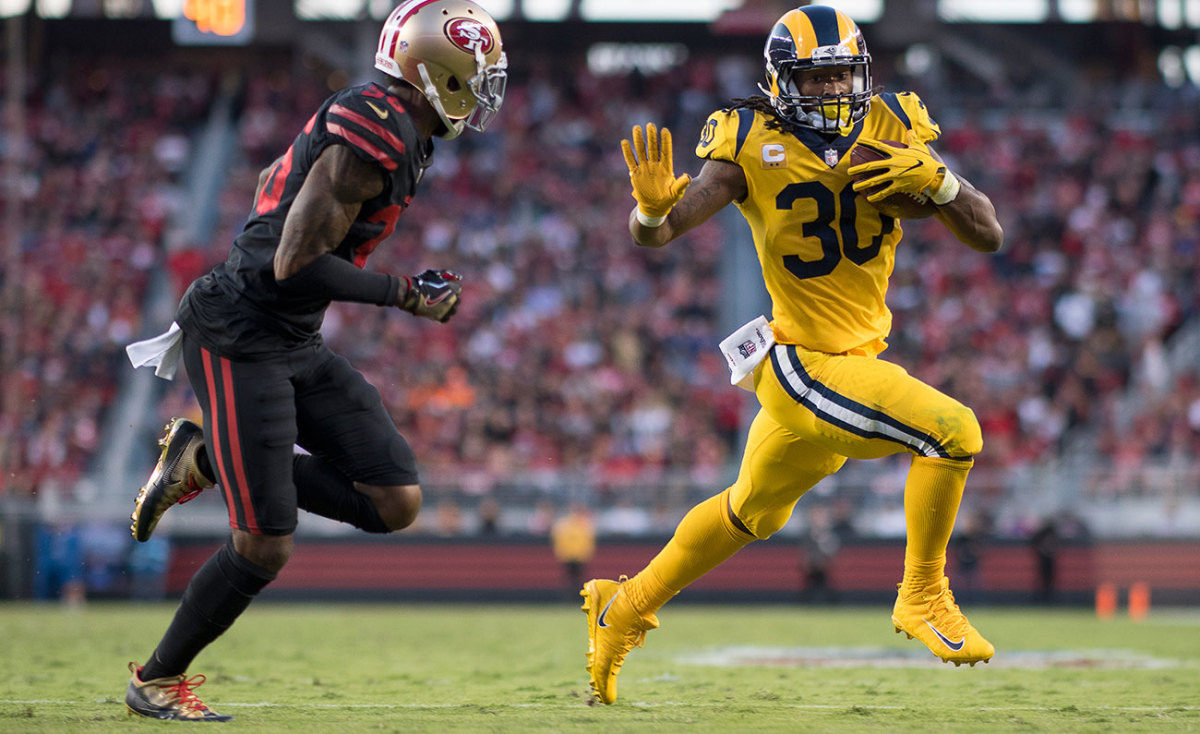
Ask either McVay or Shanahan about integrating backs into aerial designs, and they’ll launch into elaborate soliloquies about the nuances of that execution.
“Both guys are as detailed as anybody I’ve been around,” says LaFleur. “They do a great job of seeing the game with all 22 players in mind.”
They also see a game with its recent past and immediate future in mind. “They don’t just spin a rolodex and pick out a play and hope it works,” says Cousins. “They have a reason for every play they call. And I think in coaching that isn’t as common as you think. A lot of coaches feel comfortable just pulling plays out of a hat and hoping a few of them work. “
If the Niners and Rams fulfill expectations, plenty of NFL teams will start searching for the next young offensive-minded head coach. LaFleur’s background with both men, especially if it’s coupled with a strong performance from a Titans offense that lacks speed at wide receiver and is partly reworking quarterback Marcus Mariota, would propel him up many lists. (Though brace yourself for a cold dismissal if you bring this up to him. “We’re just trying to get the next practice right,” he says.)
The trend toward young offensive coaches includes not just McVay and Shanahan, but new Bears head coach Matt Nagy, 39, and Adam Gase, who took Miami to the playoffs as a 38-year-old rookie head coach in 2016. Others are in waiting. Not only are six coordinators 40 or younger (LaFleur, Minnesota’s John DeFilippo, Jacksonville’s Nathaniel Hackett, Indianapolis’s Nick Sirianni, Detroit’s Jim Bob Cooter and Miami’s Dowell Loggains), but 15 quarterbacks coaches are 40 or younger.
• CALIFORNIA WEEK: Andy Benoit and The MMQB on why 2018 will be golden in the Golden State
That’s what’s happening around the rest of the league. Inside the NFC West, the stage is set for the two offensive innovators to clash for years to come. McVay’s quarterback is 23 years old; Shanahan’s is 26, with very little wear-and-tear. L.A.’s roster is loaded; San Fran’s is solid and improving. The Rams will move into a new world-class stadium in 2020; the Niners have been in theirs since 2014.
The rivalry will be fun … even if neither coach wants to stoke it publicly. Both say all the right things about the other, and behind the scenes their mutual respect might be even more intense. But every now and then you see competitive juices leaking out. A good-natured potshot about that guy stealing my idea. An unnecessary mention about how he’s in our division. Memories of interviewing for the same coaching jobs. (McVay met with the 49ers in 2017, Shanahan was scheduled to meet with the Rams that year until a snowstorm before a Falcons playoff game derailed it.) A sly smile when talking about last year’s Week 3 Thursday night shootout, when Shanahan’s offense put up 39 and McVay’s scored 41, but with the help of an early Nickell Robey-Coleman interception return that gave L.A. the ball at the three-yard-line. (Gurley scored a touchdown one snap later.) These are the two biggest offensive trend-setters in the NFL right now. It’d be naïve to think they don’t want to beat each other.
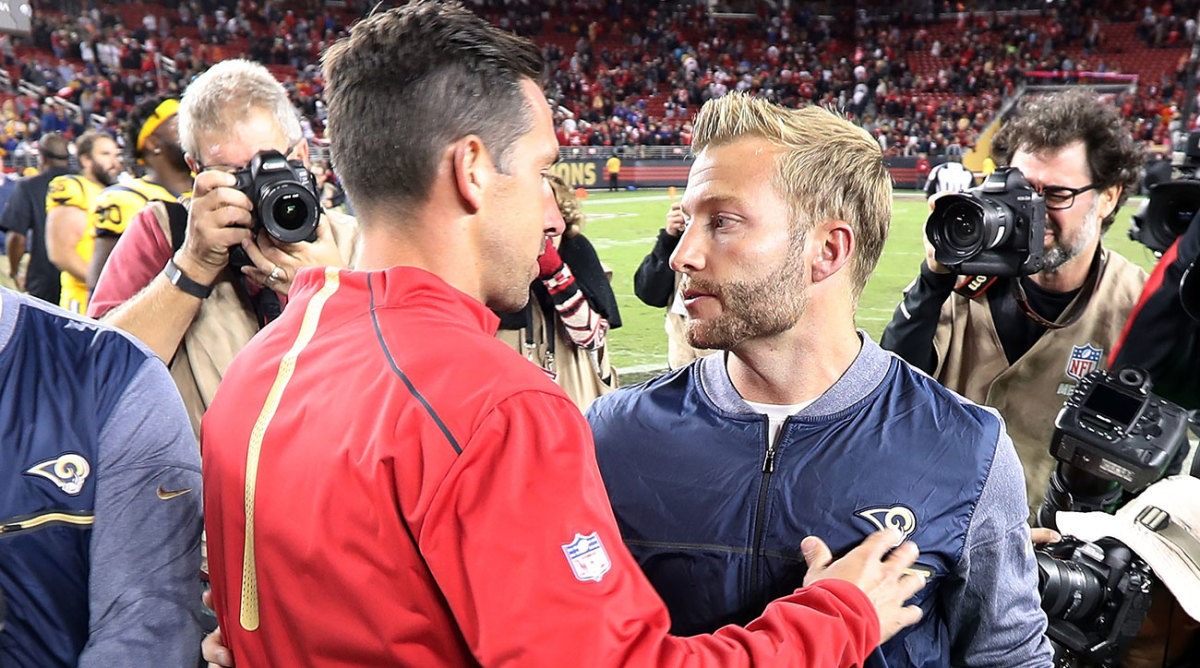
Question or comment? Email us at talkback@themmqb.com.
